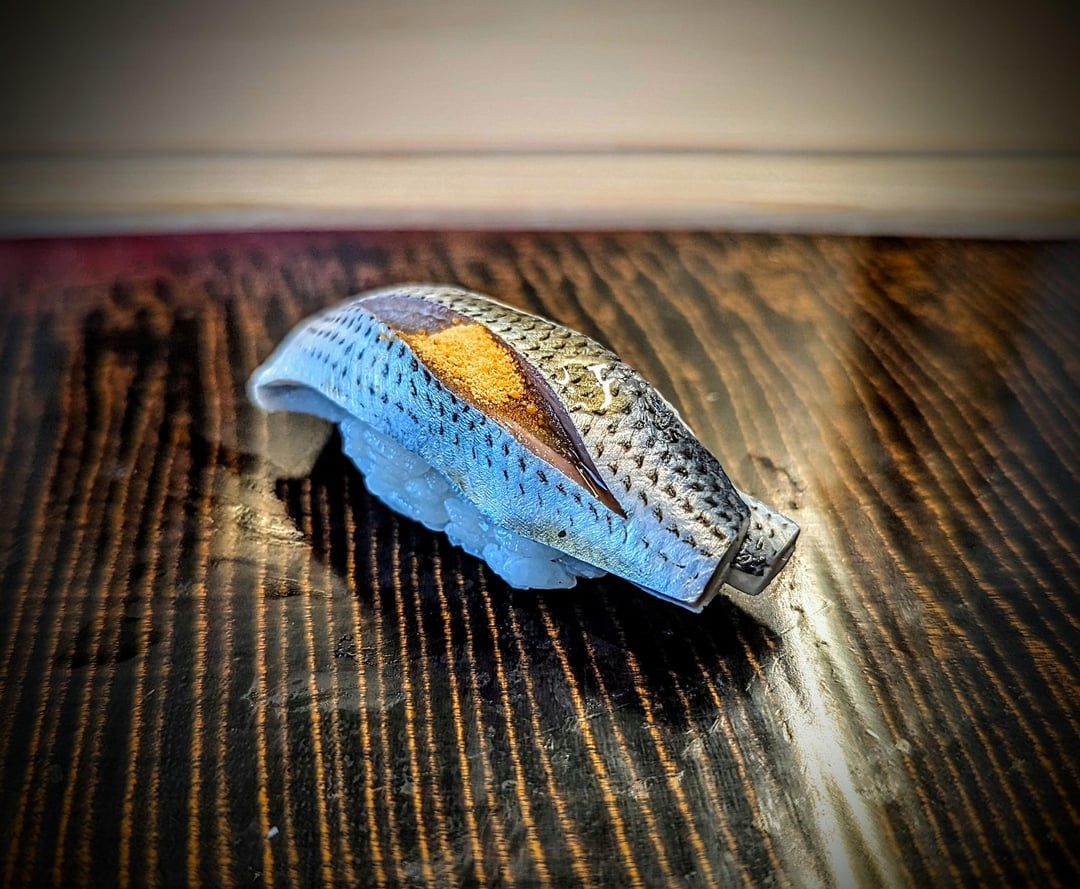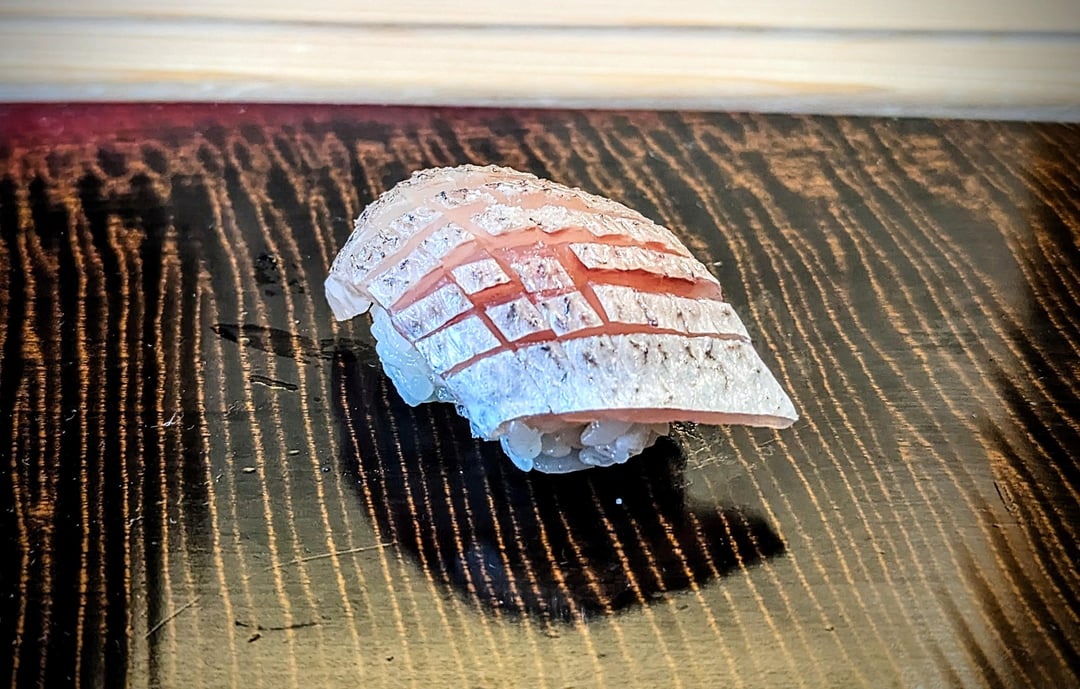





I recently returned from a two-week trip to Tokyo, where I ate at 12 fine dining establishments (7 of which were sushiyas), as well as a number of casual spots. The summary of each of these visits can be found at the following link: https://www.reddit.com/r/finedining/s/fu79pmg4dp
My second restaurant visit for this trip, Sushi Namba Hibiya is on the third floor of the Midtown building, a short walk from Ginza station and next to Hibiya park. I secured a reservation at the four-seat private counter (typically all-foreigner) through Tableall a couple of days in advance, for a lunch service that consisted of eight otsumami, fifteen nigiri, and a tamago dessert.
As with Sushi Mizukami the night before, there is a hushed atmosphere, both in the private counter (which is understandable, given myself and the other guests' lack of Japanese), and from what I could hear over at the main counter. To begin the meal, the otsumami is served by an apprentice while Namba-san is finishing off the nigiri for the main counter. Octopus (marinated in soy, grilled, and served with a small hill of wasabi atop it), kinki fish (sweet flesh, crispy skin, served in a light broth), botan ebi (perhaps the best otsumami of the meal and one of the highlight bites of the trip, the shrimp sweet and glistening, topped with an ebi-miso paste), ankimo (steamed monkfish liver, served in a ponzu sauce), whale (a cut from the tail, pictured), abalone (thinly sliced and served in a broth made using the liver), and anago (grilled to a delectable crispiness, and served with greens).
There was a short wait after the last of these otsumami while Namba-san finished up at the main counter. When he made his appearance, the fifteen nigiri followed in quick succession. A thing that sets Sushi Namba Hibiya apart from other sushiyas is a preoccupation with temperature control; shari (where red vinegar is used for the richer-flavoured fish – exempting the tuna – while a sweeter rice vinegar is used for the white-flesh fish, as well as the tuna) and neta both are prepared at distinct temperatures, which are listed on a menu that accompanies the nigiri. The following nigiri were offered at the meal I attended, where the temperatures stated are in degrees centigrade (the larger number is the temperature of the shari, the smaller the temperature of the neta):
- Swordtip Squid (36, 17)
- Red sea-bream (36, 20)
- Halfbeak (38, 22)
- Hen-Clam (36, 17)
- Crimson Sea-Bream (37, 22)
- Sardine (36, 18)
- Oceanic Bonito (38, 21)
- Spanish Mackerel (37, 20)
- Chub Mackerel (38, 20)
- Abalone
- Sea Urchin
- Akami (36, 21)
- Chutoro (38, 23)
- Kohada (36, 19)
- Anago (39, 36)
While there wasn't an imbalanced nigiri among the fifteen, a few in particular stood out. The sardine, from Hokkaido and lightly seasoned, was delicious and perhaps even preferable to the kohada (which is a personal favourite). The anago had a pleasingly crispy exterior, and the sweet tsume made from its own stock was a luxurious way to end the sequence. Crisp, refreshing uni sat atop a small hill of rice that itself was plated within a savoury viscous sauce (while I would prefer uni sushi that I can hold in my hand, the freshness of the uni was noteworthy). And the chutoro and akami, so rarely disappointing, did not here; the chutoro was one of the most melt-in-the-mouth pieces of fish I encountered during my trip, second only to that offered at Sawada.
The meal went at a brisk pace, lasting for between 1.5 to 2 hours, with the fact that there were only four of us at the counter probably the main contributing factor (so that the nigiri, being sequential, was rattled through). I enjoyed my meal at Sushi Namba Hibiya, especially the aforementioned nigiri, but felt that the flavours were more pronounced at some of the other sushiyas (Mizukami, Takamitsu, and Sawada). In addition, I am dubious about the supposed temperature control, or at least the impact upon serving. While the shari and neta may well have been prepared at the given temperatures, similar things are going to happen for both: for the fish, which are prepared at around room temperature, they were not vacuum-sealed and temperature-controlled up to the point of serving; they were left for a not insignificant amount of time at ambient temperature, and so each will come up or down depending on this. For the shari, which is prepared at a higher temperature than room temperature, I did not see different hangiri/warabitsu being used for the different nigiri; all of the rice seemed to come from the same container. Though this may be partitioned, again there is the problem of temperature control without the use of specific equipment (that was not in evidence). So while it is perfectly possible that the rice and the fish has been prepared at specific, different temperatures, the serving temperature is going to be very similar across the board. As such, I think it should be made clearer that these are the temperatures that the ingredients are prepared at, and not the temperatures that you will actually experience as you eat the nigiri. Of course, this hypothesis has been arrived at from observations over the course of a sitting; I would be pleased to be proven otherwise.
Ultimately though, I don't think temperature control should be the main selling point. As with anything food, the bottom line is flavour, and Sushi Namba Hibiya certainly has that in spades.
by MaaDFoXX


2 Comments
Great write up! The iwashi nigiri I had there around this time last year might have been the best single piece of sushi I’ve ever had.
The temperature thing isn’t too be taken too seriously IMO.
Every time I went, you could tell the variance is likely at least 5 if not more degrees.
It’s just a general intent from the chef imo and not something to be worrying about too much.
That said, I do agree that the fact he gives a menu with a temperature to the degree of the shari/neta is kind of making you expect some sort of strict control. They should just drop it IMO.